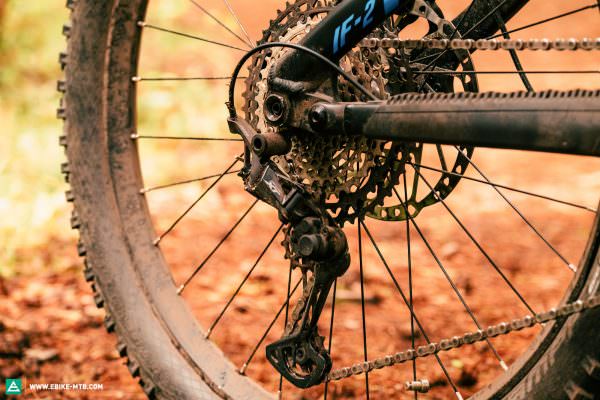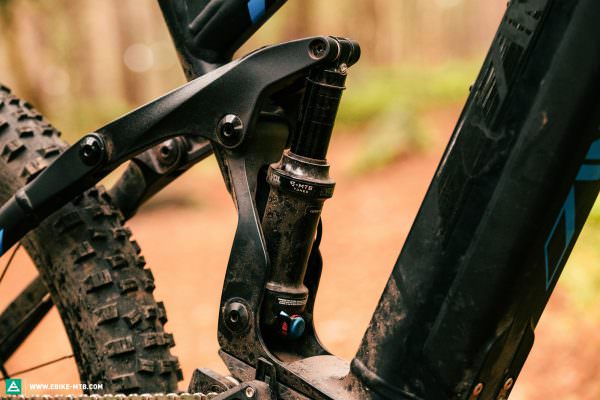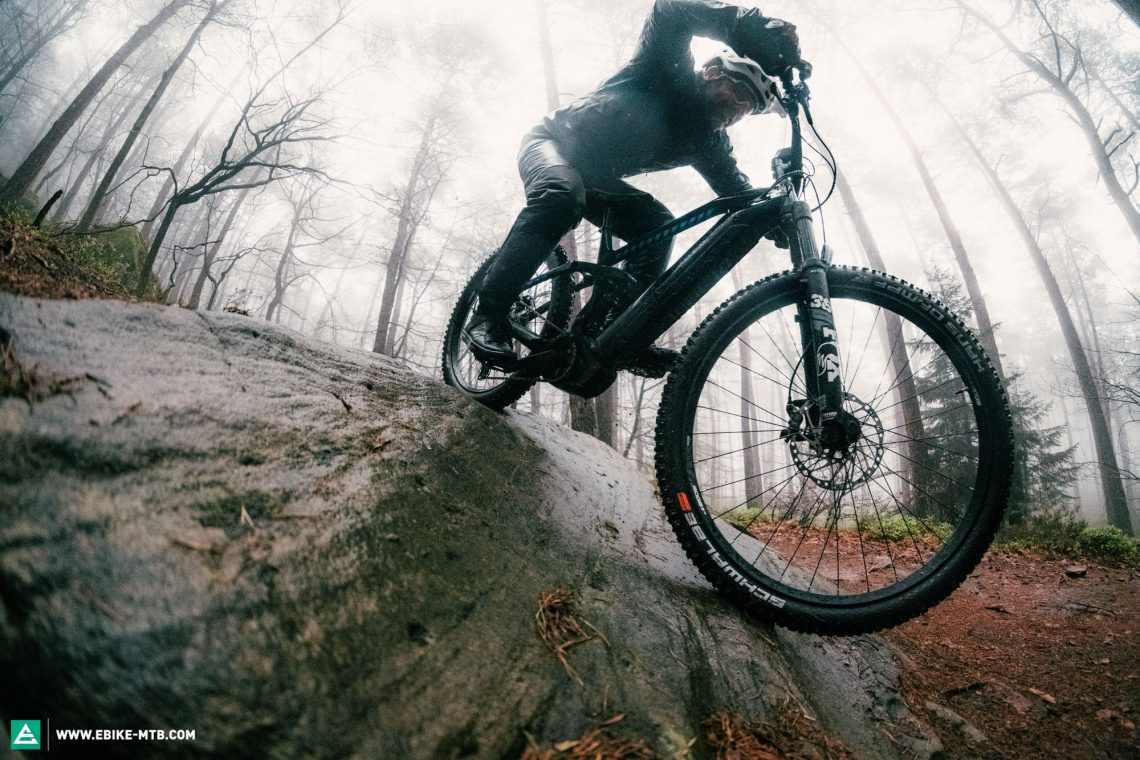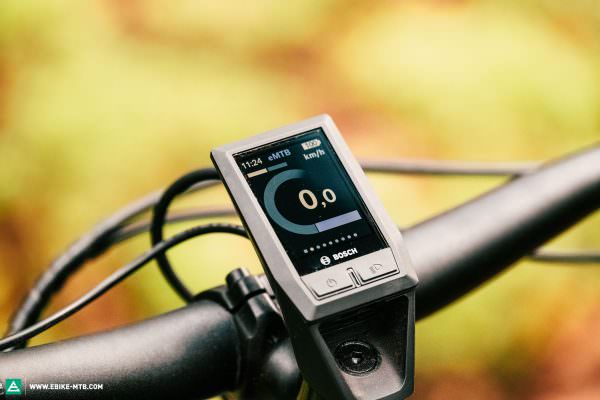Young German brand INFRONT offer affordable eMTBs. But are they good value for money? We pitted the INFRONT IF-2.1 Fully with its Bosch motor and 625 Wh battery against the competition of our budget group test. Can the € 4,900 bike convince on the trail?
For an overview of the test fleet head to the group test: The best eMTB of 2021 for € 5,500 – 7 budget eMTBs go head to head

25.10 kg in size L | € 4,900 | Manufacturer’s website
The INFRONT IF-2.1 Fully is the second full-suspension eMTB from the young German brand. It comes equipped with a Bosch Performance Line CX motor and big 625 Wh battery and relies on 150 mm suspension and a mixed wheel setup with a large 29” wheel at the front and smaller 27.5” one at the rear. Priced at € 4,900, it is by far the cheapest bike in our 2021 budget group test. Despite the low price, INFRONT’s mini configurator lets you pick and change ergonomically-relevant components such as the saddle, grips and stem. INFRONT will help you make the right choice – cool! The Bosch motor sits proud of the INFRONT’s frame and is protected by a plastic cover. Unfortunately, the overall integration of the Bosch system is subpar, as INFRONT still rely on a flimsy and outdated spoke magnet. Given that the alloy frame of the 25.10 kg bike in size L was designed to accommodate a fully integrated speed sensor in the dropout, we don’t understand why. On top of that, the display mount puts the KIOX display in an exposed position on top of the stem, where it can quickly get lost – make sure it’s screwed on tightly! INFRONT’s in-house magnetic charge port cover on the top tube is very practical, easy to access and so much better than Bosch’s standard solution. At 94 kg, the IF-2.1 has a very low maximum payload.



The INFRONT IF-2.1 is not specced for the trail
Given that the INFRONT IF-2.1 is the cheapest bike in our 2021 budget group test, you’re probably asking yourself where the German brand has saved. At first glance, the spec list looks promising: a Shimano XT 12-speed drivetrain, Shimano XT four-piston brakes with 200 mm rotors and 150 mm FOX suspension with a 36 Performance fork and DPS shock. Furthermore, Shimano’s I-SPEC mounts ensure excellent cockpit ergonomics – exemplary! Unfortunately, the spec still has some major weaknesses. For example, the wheelset consisting of Ryde Edge M 35 rims and Shimano XT hubs had to be serviced after just a few kilometres on the trail. And what’s up with the dropper post with just 125 mm travel on a size L? That’s not enough, nor is the 29 x 2.3” Schwalbe Hans Dampf front tire a great choice for trail riding. Despite the super wide 2.8″ rear tire, the tire combination on our test bike prevents the bike from reaping the full benefits of a mixed wheel setup. The small 27.5″ wheel runs a Schwalbe Hans Dampf rear tire with puncture-prone Apex casing and hard ADDIX Speedgrip rubber compound. To prevent pinch flats, you’ll have to run high air pressures and, as a result, the rear tire struggles to find grip. Nevertheless, INFRONT are speccing the production bike with more robust Super Gravity casing tires.
The spec of the INFRONT IF-2.1 Fully can’t convince on the trail.

The INFRONT comes equipped with a Shimano XT drivetrain and matching brakes with 200 mm rotors. We approve!

The stiff suspension of the INFRONT offers enough support on flowing trails but fails to generate traction on technical terrain.
INFRONT IF-2.1 Fully
€ 4,900
Specifications
Motor Bosch Performance Line CX 85 Nm
Battery Bosch PowerTube 625 Wh
Display Bosch Kiox
Fork FOX 36 Performance GRIP 150 mm
Rear Shock FOX DPS 150 mm
Seatpost KS Rage-i 100–150 mm
Brakes Shimano XT M8120 200/200 mm
Drivetrain Shimano XT 1x12
Stem Promax DA-22831 50 mm
Handlebar Promax HB-3188 DB31 780 mm
Wheelset Ryde Edge M 35/Shimano XT 29"/27.5"
Tires Schwalbe Hans Dampf Super Gravity/Apex 2.4/2.8"
Technical Data
Size S M L XL
Weight 25.10 kg
Perm. total weight 120 kg
Max. payload (rider/equipment) 94 kg
Trailer approval yes
Kickstand mount no
Specific Features
Mini configurator for the grips, saddle and stem length

Why isn’t the speed sensor integrated into the dropout? The frame is already prepared for it! Here a less vulnerable and tidier solution makes much more sense!

The Bosch Performance Line CX motor sits proud of the frame and is protected by a plastic cover.

Our test bike wasn’t able to reap the benefits of a mixed-wheel setup. The Schwalbe Hans Dampf rear tire with the puncture-prone Apex carcass and hard ADDIX Speedgrip rubber compound doesn’t generate enough traction. INFRONT will be delivering the production bike with the more robust Super Gravity casing.
The riding position, geometry and touring suitability of the INFRONT IF-2.1 Fully
The INFRONT IF-2.1 Fully is available in four sizes. The geometry combines a moderate 66.5° head angle, long 450 mm chainstays and a compact 459 mm reach (size L). Like the Canyon Spectral:ON, the INFRONT relies on a super wide saddle with a raised tail to prevent the rider from sliding back on steep climbs. However, on level terrain the SQlab 610 saddle with its two-stage wave shape and raised tail pushes you forward and, combined with the low front, puts too much pressure on your hands. The pedalling position of the INFRONT is ideal for climbs but not suited to easy strolls around the lake. Besides that, the rear suspension doesn’t offer enough comfort for long rides and tours.
| Size | S | M | L | XL |
|---|---|---|---|---|
| Seat tube | 400 mm | 430 mm | 460 mm | 500 mm |
| Top tube | 617 mm | 627 mm | 637 mm | 647 mm |
| Head tube | 110 mm | 110 mm | 115 mm | 120 mm |
| Head angle | 66.5° | 66.5° | 66.5° | 66.5° |
| Seat angle | 74.0° | 74.0° | 74.0° | 74.0° |
| Chainstays | 450 mm | 450 mm | 450 mm | 450 mm |
| BB Drop | 10 mm | 10 mm | 10 mm | 10 mm |
| Wheelbase | 1,204 mm | 1,214 mm | 1,225 mm | 1,236 mm |
| Reach | 440 mm | 450 mm | 459 mm | 467 mm |
| Stack | 618 mm | 618 mm | 623 mm | 627 mm |

Pants GORE C5 Paclite Trail | Shoes Five Ten Freerider DLX | Gloves GORE C5 Trail
The INFRONT IF-2.1 Fully on the trail
Going uphill, the pronounced kink in the seat tube combined with the slack seat tube angle positions the rider far back over the rear wheel, especially if you have long legs. Surely, this causes the front to lift off the ground? Actually, it doesn’t! Even on steep ramps, the shock sits high in its travel and, together with the long chainstays and low front, keeps the front wheel planted – no doubt, the special saddle helps with this too. On flowing uphills, the INFRONT is easy to ride and forges its way up the hill willingly. However, even over small obstacles, the rear suspension and rear tire struggle to generate traction, not least because the latter requires high air pressures. Instead of swallowing edges and obstacles, the rear wheel bounces off them and quickly loses grip. As a result, it can no longer transfer the power of the motor to the trail, causing the bike to get stuck on steps, edges and obstacles. While the same tire with a more robust casing would offer more support and increased puncture protection, the shallow profile doesn’t generate sufficient grip for trail riding. We’d recommend the Schwalbe Eddy Current tire fitted to the Propain Ekano AL 29 instead.

The INFRONT is easy to ride on flat trails and at low speeds. However, on steep, fast and more technical terrain, it reaches its limit


Tuning tips: dropper post with more travel | crank down the mounting screws of the Kiox display
Drop the saddle and start ripping! That’s easier said than done. Regardless of the trail, the INFRONT always struggles with the same problem: the meagre 125 mm travel of the dropper post and the wide saddle with its raised tail massively restrict freedom of movement on the bike, making it difficult to tackle technical descents. Through flat, open corners, the weight is evenly distributed between the wheels, ensuring good cornering stability and allowing you to generate speed through rollers and corners. With its long chainstays and significant weight, the INFRONT requires great physical strength, whether you’re trying to get it airborne or simply lifting the front wheel off the ground. On steep descents, the IF-2.1 reaches its limits and forces its rider to slam on the brakes. Here, the lack of freedom of movement becomes increasingly evident and prevents you from shifting your weight around the bike. As a result, the IF-2.1 doesn’t feel safe on steep technical terrain. To make things worse, the Schwalbe Hans Dampf front tire doesn’t offer enough grip. Frankly, the IF-2.1 puts you off from riding technical and demanding trails or bike park tracks. As far as assembly quality goes, INFRONT dropped the ball with our test bike. Over several small jumps and drops, the battery detached itself from the down tube. Thankfully, together with the INFRONT team, we were able to trace the problem back to an assembly error. After modifying the spacing between the two battery brackets, the battery stayed exactly where it belonged, even over larger drops.
The E-MOUNTAINBIKE team push the bikes in their tests to the absolute limit. At INFRONT, we maintain close contact with our customers. Likewise, thanks to our close cooperation with the test team, we were able to solve this technical issue successfully. We’re glad that we can continually improve our products like this.” – Markus Bauer, Chief executive INFRONT

Riding Characteristics
7Agility
- sluggish
- playful
Stability
- nervous
- stable
Handling
- demanding
- balanced
Riding fun
- boring
- lively
Motor feeling
- digital
- natural
Motor power
- weak
- strong
Value for money
- poor
- top
Conclusion
While at € 4,900 the INFRONT IF-2.1 Fully might look like a steal, considering the trail performance and fun factor it delivers, it’s actually overpriced. With its weak wheelset, short-travel dropper post, inadequate tires and poor trail performance, INFRONT’s full-suspension eMTB couldn’t convince our test team. The IF-2.1 prefers easy, flowing climbs and hilly tours over long rides on flat terrain, where the pedalling position is rather uncomfortable.
Tops
- good-natured handling at low speeds
- climbing performance on easy terrain without obstacles
- mini configurator and advice on ergonomics
Flops
- trail performance uphill and downhill
- assembly-quality
- limited comfort
- low maximum payload

You can find out more about at infront-bikes.com
The test field
For an overview of the test fleet head to the group test: The best eMTB of 2021 for € 5,500 – 7 budget eMTBs go head to head
All bikes in test: Canyon Spectral:ON CF 7 (Click for review) | FOCUS JAM² 6.9 NINE (Click for review) | Haibike AllMtn 4 (Click for review) | INFRONT IF-2.1 Fully | MERIDA eONE-SIXTY 700 (Click for review) | Propain Ekano AL 29 (Click for review) | SCOTT Ransom eRIDE 920 (Click for review)

Relaxed and comfortable riding on surfaced roads, both uphill and downhill.↩
Easy climbs up trails with few obstacles, wide turns and a moderate incline.↩
Active and playful descents on easy trails with few obstacles, wide turns and a moderate slope.↩
Single-track climbs on challenging terrain. Loose ground, steps, roots, tight corners and occasionally extreme inclines.↩
Singletrack descents on challenging terrain. Loose ground, steps, roots, tight corners and small jumps as well as some very steep descents.↩
High speed descents on sometimes very rough trails with large jumps and obstacles that you can’t roll over.↩
The rating used for riding characteristics refers to the bikes in the group test and the current state of development of eMTBs. The best bikes managed to blend supposedly opposite riding characteristics, feeling both lively and stable at the same time. The handling describes the balance of the bike on downhill sections. The information regarding motor-power refers to the ride-feeling in the overall context of the bike and not exclusively to the motor – that’s why the same motor can present different values.↩
Did you enjoy this article? If so, we would be stoked if you decide to support us with a monthly contribution. By becoming a supporter of E-MOUNTAINBIKE, you will help secure a sustainable future for high-quality cycling journalism. Click here to learn more.
Words: Photos: Jonas Müssig & Valentin Rühl









